Release time:2020-01-16 18:44 Browse:

When discussing the topic of "whether the hardness level of the outer hexagonal long screw is higher, the better", we first need to understand the importance of the hardness level for the basic industrial component of the screw, and its many effects in practical applications. Outer hexagonal long screw, as a key part of connection and fastening, its performance is directly related to the stability, safety and service life of the entire mechanical structure. Hardness, as a physical quantity that measures the ability of a material to resist local pressure and produce deformation, plays a crucial role in the outer hexagonal long screw.
Definition and classification of hardness grades
Hardness levels are usually divided by a series of criteria, such as Rockwell hardness (HR), Brinell hardness (HB), Vickers hardness (HV), etc., each method has its own specific scope of application and measurement principles. For outer hexagonal long screws, the choice of hardness level is often based on many factors such as its working environment, stress, material characteristics and manufacturing process.
Advantages of high hardness rating
1. Higher bearing capacity: Screws with high hardness levels are less prone to plastic deformation or fracture when they bear the same load, thus improving the reliability and durability of the connection.
2. Better wear resistance: High hardness means that the surface of the material is more resistant to wear, which is particularly important for applications that are often subjected to friction or vibration.
3. Higher corrosion resistance (indirect effect) : Although the hardness itself does not directly determine the corrosion resistance, high hardness materials are often accompanied by better organizational structure and density, which indirectly improves the corrosion resistance.
Potential problems with high hardness grades
However, higher hardness levels are not always better. Excessive hardness can cause a series of problems:
1. Increased processing difficulty: high hardness materials require higher cutting forces and more wear-resistant tools in the processing process, increasing production costs and processing difficulty.
2, toughness reduction: hardness and toughness are often inversely proportional, too high hardness may lead to screws in the impact or sudden load more easily brittle, but reduce the safety of the overall structure.
3. Compatibility problems: If the hardness of the screw is much higher than the hardness of the connected parts or nuts, it may leave indentation on the connected parts, and even cause damage to the connected parts, affecting the tightness and tightness of the connection.
4. Rising costs: High-hardness materials tend to be more expensive, and have higher requirements for storage and transportation conditions, increasing the overall cost.
Selection principle in practical application
Therefore, when selecting the hardness level of the outer hexagonal long screw, the following factors need to be considered:
- Working environment: including temperature, humidity, corrosion, etc., these factors will directly affect the performance requirements of screws.
- Stress: Analyze the maximum load, impact and vibration that the screw may withstand during use to determine the minimum hardness required.
- Material matching: Ensure that the hardness between the screw and the connected part matches to avoid matching problems caused by too hard or too soft.
- Cost-effectiveness: under the premise of meeting the performance requirements, taking into account the cost factor, choose the most cost-effective hardness grade.
conclusion
In summary, the hardness level of the outer hexagonal long screw is not the higher the better, but it needs to be reasonably selected according to the specific application scenarios and needs. Only after fully understanding the impact of hardness level on screw performance, and comprehensive consideration of various factors, can the best choice be made. Therefore, in practical applications, engineers and purchasers should have a deep understanding of product characteristics and conditions of use, and work closely with suppliers to determine the most suitable hardness level to ensure the stable, safe and efficient operation of mechanical structures.

